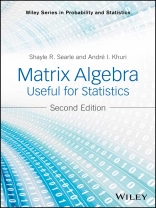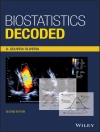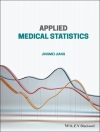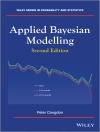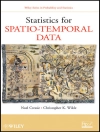A thoroughly updated guide to matrix algebra and it uses in statistical analysis and features SAS®, MATLAB®, and R throughout
This Second Edition addresses matrix algebra that is useful in the statistical analysis of data as well as within statistics as a whole. The material is presented in an explanatory style rather than a formal theorem-proof format and is self-contained. Featuring numerous applied illustrations, numerical examples, and exercises, the book has been updated to include the use of SAS, MATLAB, and R for the execution of matrix computations. In addition, André I. Khuri, who has extensive research and teaching experience in the field, joins this new edition as co-author. The Second Edition also:
- Contains new coverage on vector spaces and linear transformations and discusses computational aspects of matrices
- Covers the analysis of balanced linear models using direct products of matrices
- Analyzes multiresponse linear models where several responses can be of interest
- Includes extensive use of SAS, MATLAB, and R throughout
- Contains over 400 examples and exercises to reinforce understanding along with select solutions
- Includes plentiful new illustrations depicting the importance of geometry as well as historical interludes
Matrix Algebra Useful for Statistics, Second Edition is an ideal textbook for advanced undergraduate and first-year graduate level courses in statistics and other related disciplines. The book is also appropriate as a reference for independent readers who use statistics and wish to improve their knowledge of matrix algebra.
THE LATE SHAYLE R. SEARLE, PHD, was professor emeritus of biometry at Cornell University. He was the author of Linear Models for Unbalanced Data and Linear Models and co-author of Generalized, Linear, and Mixed Models, Second Edition, Matrix Algebra for Applied Economics, and Variance Components, all published by Wiley. Dr. Searle received the Alexander von Humboldt Senior Scientist Award, and he was an honorary fellow of the Royal Society of New Zealand.
ANDRÉ I. KHURI, PHD, is Professor Emeritus of Statistics at the University of Florida. He is the author of Advanced Calculus with Applications in Statistics, Second Edition and co-author of Statistical Tests for Mixed Linear Models, all published by Wiley. Dr. Khuri is a member of numerous academic associations, among them the American Statistical Association and the Institute of Mathematical Statistics.
Daftar Isi
Preface xvii
Preface to the First Edition xix
Introduction xxi
About the Companion Website xxxi
Part I Definitions, Basic Concepts, and Matrix Operations 1
1 Vector Spaces, Subspaces, and Linear Transformations 3
1.1 Vector Spaces 3
1.1.1 Euclidean Space 3
1.2 Base of a Vector Space 5
1.3 Linear Transformations 7
1.3.1 The Range and Null Spaces of a Linear Transformation 8
Reference 9
Exercises 9
2 Matrix Notation and Terminology 11
2.1 Plotting of a Matrix 14
2.2 Vectors and Scalars 16
2.3 General Notation 16
Exercises 17
3 Determinants 21
3.1 Expansion by Minors 21
3.1.1 First- and Second-Order Determinants 22
3.1.2 Third-Order Determinants 23
3.1.3 n-Order Determinants 24
3.2 Formal Definition 25
3.3 Basic Properties 27
3.3.1 Determinant of a Transpose 27
3.3.2 Two Rows the Same 28
3.3.3 Cofactors 28
3.3.4 Adding Multiples of a Row (Column) to a Row (Column) 30
3.3.5 Products 30
3.4 Elementary Row Operations 34
3.4.1 Factorization 35
3.4.2 A Row (Column) of Zeros 36
3.4.3 Interchanging Rows (Columns) 36
3.4.4 Adding a Row to a Multiple of a Row 36
3.5 Examples 37
3.6 Diagonal Expansion 39
3.7 The Laplace Expansion 42
3.8 Sums and Differences of Determinants 44
3.9 A Graphical Representation of a 3 × 3 Determinant 45
References 46
Exercises 47
4 Matrix Operations 51
4.1 The Transpose of a Matrix 51
4.1.1 A Reflexive Operation 52
4.1.2 Vectors 52
4.2 Partitioned Matrices 52
4.2.1 Example 52
4.2.2 General Specification 54
4.2.3 Transposing a Partitioned Matrix 55
4.2.4 Partitioning Into Vectors 55
4.3 The Trace of a Matrix 55
4.4 Addition 56
4.5 Scalar Multiplication 58
4.6 Equality and the Null Matrix 58
4.7 Multiplication 59
4.7.1 The Inner Product of Two Vectors 59
4.7.2 A Matrix–Vector Product 60
4.7.3 A Product of Two Matrices 62
4.7.4 Existence of Matrix Products 65
4.7.5 Products With Vectors 65
4.7.6 Products With Scalars 68
4.7.7 Products With Null Matrices 68
4.7.8 Products With Diagonal Matrices 68
4.7.9 Identity Matrices 69
4.7.10 The Transpose of a Product 69
4.7.11 The Trace of a Product 70
4.7.12 Powers of a Matrix 71
4.7.13 Partitioned Matrices 72
4.7.14 Hadamard Products 74
4.8 The Laws of Algebra 74
4.8.1 Associative Laws 74
4.8.2 The Distributive Law 75
4.8.3 Commutative Laws 75
4.9 Contrasts With Scalar Algebra 76
4.10 Direct Sum of Matrices 77
4.11 Direct Product of Matrices 78
4.12 The Inverse of a Matrix 80
4.13 Rank of a Matrix—Some Preliminary Results 82
4.14 The Number of LIN Rows and Columns in a Matrix 84
4.15 Determination of the Rank of a Matrix 85
4.16 Rank and Inverse Matrices 87
4.17 Permutation Matrices 87
4.18 Full-Rank Factorization 89
4.18.1 Basic Development 89
4.18.2 The General Case 91
4.18.3 Matrices of Full Row (Column) Rank 91
References 92
Exercises 92
5 Special Matrices 97
5.1 Symmetric Matrices 97
5.1.1 Products of Symmetric Matrices 97
5.1.2 Properties of AA′ and A′A 98
5.1.3 Products of Vectors 99
5.1.4 Sums of Outer Products 100
5.1.5 Elementary Vectors 101
5.1.6 Skew-Symmetric Matrices 101
5.2 Matrices Having All Elements Equal 102
5.3 Idempotent Matrices 104
5.4 Orthogonal Matrices 106
5.4.1 Special Cases 107
5.5 Parameterization of Orthogonal Matrices 109
5.6 Quadratic Forms 110
5.7 Positive Definite Matrices 113
References 114
Exercises 114
6 Eigenvalues and Eigenvectors 119
6.1 Derivation of Eigenvalues 119
6.1.1 Plotting Eigenvalues 121
6.2 Elementary Properties of Eigenvalues 122
6.2.1 Eigenvalues of Powers of a Matrix 122
6.2.2 Eigenvalues of a Scalar-by-Matrix Product 123
6.2.3 Eigenvalues of Polynomials 123
6.2.4 The Sum and Product of Eigenvalues 124
6.3 Calculating Eigenvectors 125
6.3.1 Simple Roots 125
6.3.2 Multiple Roots 126
6.4 The Similar Canonical Form 128
6.4.1 Derivation 128
6.4.2 Uses 130
6.5 Symmetric Matrices 131
6.5.1 Eigenvalues All Real 132
6.5.2 Symmetric Matrices Are Diagonable 132
6.5.3 Eigenvectors Are Orthogonal 132
6.5.4 Rank Equals Number of Nonzero Eigenvalues for a Symmetric Matrix 135
6.6 Eigenvalues of Orthogonal and Idempotent Matrices 135
6.6.1 Eigenvalues of Symmetric Positive Definite and Positive Semidefinite Matrices 136
6.7 Eigenvalues of Direct Products and Direct Sums of Matrices 138
6.8 Nonzero Eigenvalues of AB and BA 140
References 141
Exercises 141
7 Diagonalization of Matrices 145
7.1 Proving the Diagonability Theorem 145
7.1.1 The Number of Nonzero Eigenvalues Never Exceeds Rank 145
7.1.2 A Lower Bound on r (A − λkI) 146
7.1.3 Proof of the Diagonability Theorem 147
7.1.4 All Symmetric Matrices Are Diagonable 147
7.2 Other Results for Symmetric Matrices 148
7.2.1 Non-Negative Definite (n.n.d.) 148
7.2.2 Simultaneous Diagonalization of Two Symmetric Matrices 149
7.3 The Cayley–Hamilton Theorem 152
7.4 The Singular-Value Decomposition 153
References 157
Exercises 157
8 Generalized Inverses 159
8.1 The Moore–Penrose Inverse 159
8.2 Generalized Inverses 160
8.2.1 Derivation Using the Singular-Value Decomposition 161
8.2.2 Derivation Based on Knowing the Rank 162
8.3 Other Names and Symbols 164
8.4 Symmetric Matrices 165
8.4.1 A General Algorithm 166
8.4.2 The Matrix X′X 166
References 167
Exercises 167
9 Matrix Calculus 171
9.1 Matrix Functions 171
9.1.1 Function of Matrices 171
9.1.2 Matrices of Functions 174
9.2 Iterative Solution of Nonlinear Equations 174
9.3 Vectors of Differential Operators 175
9.3.1 Scalars 175
9.3.2 Vectors 176
9.3.3 Quadratic Forms 177
9.4 Vec and Vech Operators 179
9.4.1 Definitions 179
9.4.2 Properties of Vec 180
9.4.3 Vec-Permutation Matrices 180
9.4.4 Relationships Between Vec and Vech 181
9.5 Other Calculus Results 181
9.5.1 Differentiating Inverses 181
9.5.2 Differentiating Traces 182
9.5.3 Derivative of a Matrix with Respect to Another Matrix 182
9.5.4 Differentiating Determinants 183
9.5.5 Jacobians 185
9.5.6 Aitken’s Integral 187
9.5.7 Hessians 188
9.6 Matrices with Elements That Are Complex Numbers 188
9.7 Matrix Inequalities 189
References 193
Exercises 194
Part II Applications of Matrices in Statistics 199
10 Multivariate Distributions and Quadratic Forms 201
10.1 Variance-Covariance Matrices 202
10.2 Correlation Matrices 203
10.3 Matrices of Sums of Squares and Cross-Products 204
10.3.1 Data Matrices 204
10.3.2 Uncorrected Sums of Squares and Products 204
10.3.3 Means, and the Centering Matrix 205
10.3.4 Corrected Sums of Squares and Products 205
10.4 The Multivariate Normal Distribution 207
10.5 Quadratic Forms and χ2-Distributions 208
10.5.1 Distribution of Quadratic Forms 209
10.5.2 Independence of Quadratic Forms 210
10.5.3 Independence and Chi-Squaredness of Several Quadratic Forms 211
10.5.4 The Moment and Cumulant Generating Functions for a Quadratic Form 211
10.6 Computing the Cumulative Distribution Function of a Quadratic Form 213
10.6.1 Ratios of Quadratic Forms 214
References 215
Exercises 215
11 Matrix Algebra of Full-Rank Linear Models 219
11.1 Estimation of β by the Method of Least Squares 220
11.1.1 Estimating the Mean Response and the Prediction Equation 223
11.1.2 Partitioning of Total Variation Corrected for the Mean 225
11.2 Statistical Properties of the Least-Squares Estimator 226
11.2.1 Unbiasedness and Variances 226
11.2.2 Estimating the Error Variance 227
11.3 Multiple Correlation Coefficient 229
11.4 Statistical Properties under the Normality Assumption 231
11.5 Analysis of Variance 233
11.6 The Gauss–Markov Theorem 234
11.6.1 Generalized Least-Squares Estimation 237
11.7 Testing Linear Hypotheses 237
11.7.1 The Use of the Likelihood Ratio Principle in Hypothesis Testing 239
11.7.2 Confidence Regions and Confidence Intervals 241
11.8 Fitting Subsets of the x-Variables 246
11.9 The Use of the R(.|.) Notation in Hypothesis Testing 247
References 249
Exercises 249
12 Less-Than-Full-Rank Linear Models 253
12.1 General Description 253
12.2 The Normal Equations 256
12.2.1 A General Form 256
12.2.2 Many Solutions 257
12.3 Solving the Normal Equations 257
12.3.1 Generalized Inverses of X′X 258
12.3.2 Solutions 258
12.4 Expected Values and Variances 259
12.5 Predicted y-Values 260
12.6 Estimating the Error Variance 261
12.6.1 Error Sum of Squares 261
12.6.2 Expected Value 262
12.6.3 Estimation 262
12.7 Partitioning the Total Sum of Squares 262
12.8 Analysis of Variance 263
12.9 The R(⋅|⋅) Notation 265
12.10 Estimable Linear Functions 266
12.10.1 Properties of Estimable Functions 267
12.10.2 Testable Hypotheses 268
12.10.3 Development of a Test Statistic for H0 269
12.11 Confidence Intervals 272
12.12 Some Particular Models 272
12.12.1 The One-Way Classification 272
12.12.2 Two-Way Classification, No Interactions, Balanced Data 273
12.12.3 Two-Way Classification, No Interactions, Unbalanced Data 276
12.13 The R(⋅|⋅) Notation (Continued) 277
12.14 Reparameterization to a Full-Rank Model 281
References 282
Exercises 282
13 Analysis of Balanced Linear Models Using Direct Products of Matrices 287
13.1 General Notation for Balanced Linear Models 289
13.2 Properties Associated with Balanced Linear Models 293
13.3 Analysis of Balanced Linear Models 298
13.3.1 Distributional Properties of Sums of Squares 298
13.3.2 Estimates of Estimable Linear Functions of the Fixed Effects 301
References 307
Exercises 308
14 Multiresponse Models 313
14.1 Multiresponse Estimation of Parameters 314
14.2 Linear Multiresponse Models 316
14.3 Lack of Fit of a Linear Multiresponse Model 318
14.3.1 The Multivariate Lack of Fit Test 318
References 323
Exercises 324
Part III Matrix Computations and Related Software 327
15 SAS/IML 329
15.1 Getting Started 329
15.2 Defining a Matrix 329
15.3 Creating a Matrix 330
15.4 Matrix Operations 331
15.5 Explanations of SAS Statements Used Earlier in the Text 354
References 357
Exercises 358
16 Use of MATLAB in Matrix Computations 363
16.1 Arithmetic Operators 363
16.2 Mathematical Functions 364
16.3 Construction of Matrices 365
16.3.1 Submatrices 365
16.4 Two- and Three-Dimensional Plots 371
16.4.1 Three-Dimensional Plots 374
References 378
Exercises 379
17 Use of R in Matrix Computations 383
17.1 Two- and Three-Dimensional Plots 396
17.1.1 Two-Dimensional Plots 397
17.1.2 Three-Dimensional Plots 404
References 408
Exercises 408
Appendix 413
Index 475
Tentang Penulis
The late Shayle R. Searle, Ph D, was professor emeritus of biometry at Cornell University. He was the author of Linear Models for Unbalanced Data and Linear Models and co-author of Generalized, Linear, and Mixed Models, Second Edition, Matrix Algebra for Applied Economics, and Variance Components, all published by Wiley. Dr. Searle received the Alexander von Humboldt Senior Scientist Award, and he was an honorary fellow of the Royal Society of New Zealand.
André I. Khuri, Ph D, is Professor Emeritus of Statistics at the University of Florida. He is the author of Advanced Calculus with Applications in Statistics, Second Edition and co-author of Statistical Tests for Mixed Linear Models, all published by Wiley. Dr. Khuri is a member of numerous academic associations, among them the American Statistical Association and the Institute of Mathematical Statistics.
